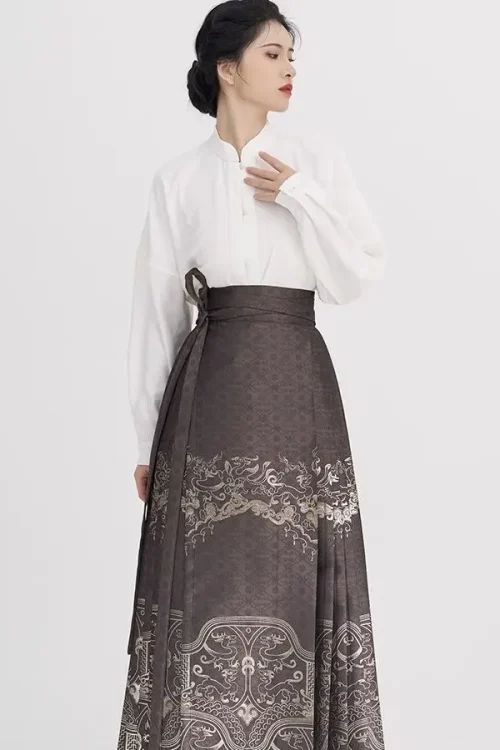The Mamianqun, or horse-face pleated skirt, is a classic garment in ancient Chinese fashion, representing one of the most iconic pieces of traditional clothing. As described by Meng Hui in The Slit Skirt, “This type of Song skirt consists of two equal and independent skirt hems. When making the skirt, the two pieces are partially overlapped and then sewn to the waistband.”
This traditional garment, consisting of a horse-face panel and pleats, was a popular skirt style for ancient Chinese women. Its rich history reflects the cultural and aesthetic transitions across different dynasties.

Development Over Time
Song Dynasty: The Origins of the 马绵群
The roots of the Mamianqun can be traced back to the Song Dynasty, where it was originally known as the “whirling skirt.” This skirt design, created for practical reasons, allowed women to ride donkeys comfortably, hence its alternate name, the “split skirt.”
Yuan Dynasty: Establishing the Structure
Early forms of the Mamianqun have been found in tombs from the Yuan Dynasty, suggesting that the basic structure of the skirt was established by this period.
Ming Dynasty: Widespread Use and Decoration
During the Ming Dynasty, the Mamianqun saw further development and broader adoption. It featured four skirt panels, with two at the front and two at the back, overlapping in pairs, and pleats on the sides. The waistband was often made from white fabric, symbolizing longevity. Ming Dynasty Mamianqun were frequently embellished with embroidered hems, demonstrating the diverse and rich styles of the time.

Qing Dynasty: The “Hundred Pleats Skirt”
In the Qing Dynasty, the Mamianqun continued to evolve. The pleats on either side of the “horse face” became more elaborate, sometimes reaching up to one hundred pleats, earning it the title “hundred pleats skirt.” These skirts were often more luxurious and ornate, reflecting the distinctive clothing styles of the Qing era.
Republic of China: Decline and Revival
During the Republic of China period, as Western democratic and liberal ideologies influenced Chinese fashion, traditional attire like the Mamianqun fell out of favor, replaced by Western-style clothing. However, in recent years, the revival of traditional Chinese culture, spurred by the “Guochao” movement, has brought the Mamianqun back into the public eye.
Hotspot Event: Dior’s Controversy
In 2022, Dior’s fashion show featured a mid-length black skirt described as the “iconic Dior silhouette,” which bore a striking resemblance to the traditional Mamianqun. This sparked global controversy, with many viewing it as cultural appropriation. The resulting public backlash led to protests and calls to boycott the brand.
Significance and Legacy
The Mamianqun was the signature style for women during the Ming and Qing Dynasties. Its journey across time spans the fresh elegance of Ming designs, the opulence of Qing Dynasty styles, and the refined simplicity of the Republic of China. Throughout these changes, the signature “horse face” structure remained intact. The name “Mamianqun” is believed to derive from its resemblance to ancient defensive structures, specifically the protruding sections of city walls called “horse faces.”
Mamianqun are crafted in a variety of colors and often adorned with auspicious patterns using techniques such as weaving, embroidery, painting, and dyeing. These decorative elements highlight the exceptional craftsmanship of traditional Chinese embroidery. Today, the Mamianqun enjoys a resurgence in modern fashion, appreciated for its timeless beauty and cultural significance.
In contemporary times, the Mamianqun’s revival has gained widespread attention, with many exquisite versions available on the market. The brand SinoCultural, for instance, has featured the Mamianqun in a stunning photoshoot alongside its Chinese Painting Series bags. This harmonious combination of traditional elements reflects the seamless blend of cultural inheritance and innovation, showcasing the enduring legacy of Chinese culture and craftsmanship.
